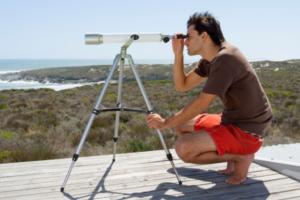Best Telescope To See Saturn & Its Rings 2025; Reviews
Disclosure: This post contains affiliate links and I may earn a small commission (at no extra cost to you) if you click through and make a purchase. Thanks in advance – I really appreciate it!
Here in this “Best Telescope To See Saturn” article we’ve rounded up 11 of the best telescopes of various types, specifications, and budget perfectly suited for viewing Saturn & its rings and other celestial objects. Below, you’ll find in-depth reviews of each, as well as an elaborate buying guide to help you pick out the one that suits you the most.
COMPARISON TABLE
| Image | Title | Best For | Features | Price | Buy |
|---|---|---|---|---|---|
Top Top
Top
Top
Top Top
Top
Top
Top | Celestron - PowerSeeker 80EQ | Best For Beginners | Aperture: 80 mm (3.15″), Focal length: 900mm, Focal Ratio: f/11 | See on Amazon | |
 Top
Top
Top
Top
Top
Top | Orion 09007 SpaceProbe 130ST | Best Reflector | Type: Reflector, Aperture: 130 mm(5.1″), Focal length: 650mm, Focal Ratio: f/5 | See on Amazon | |
 Top
Top
Top
Top
Top
Top | Celestron - PowerSeeker 127EQ | Best Compact Pick | Type: Reflector, Aperture: 127 mm(5″), Focal length: 1000mm, Focal Ratio: f/8 | See on Amazon | |
 Top
Top
Top
Top
Top
Top | Celestron - NexStar 6SE | Best Computerized | Type: Schmidt-Cassegrain, Aperture: 150mm (5.9″), Focal length: 1500mm, Focal Ratio: f/10 | See on Amazon | |
 Top
Top
Top
Top
Top
Top | Celestron - PowerSeeker 70EQ | Best Budget Pick | Aperture: 70mm (2.8″), Focal length: 700mm, Focal Ratio: f/10 | See on Amazon | |
 Top
Top
Top
Top
Top
Top | Sky-Watcher EvoStar 80 APO Doublet Refractor | Best To Photograph Saturn | Type: Apochromatic Refractor, Aperture: 80 mm(3.2″), Focal length: 600mm, Focal Ratio: f/7.5 | See on Amazon | |
 Top
Top
Top
Top
Top
Top | Orion 10014 SkyQuest XT4.5 | Best Dobsonian | Type: Newtonian Reflector, Aperture: 114mm (4.5”), Focal length: 900mm, Focal Ratio: f/7.9 | See on Amazon | |
 Top
Top
Top
Top
Top
Top | Celestron - NexStar 127SLT | Best GoTo Pick | Type: Schmidt-Cassegrain, Aperture: 127mm (5″), Focal length: 1500mm, Focal Ratio: f/12 | See on Amazon | |
 Top
Top
Top
Top
Top
Top | Celestron - NexStar 130SLT | Best Portable | Type: Newtonian Reflector, Aperture: 130mm (5.12″), Focal length: 650mm, Focal Ratio: f/5 | See on Amazon | |
 Top
Top
Top
Top
Top
Top | Celestron - AstroMaster 130EQ | Best For Amateurs | Type: Reflector, Aperture: 130 mm(5.1″), Focal length: 650mm, Focal Ratio: f/5 | See on Amazon | |
 Top
Top
Top
Top
Top
Top | Orion 10015 StarBlast 4.5 | Best Tabletop | Type: Newtonian Reflector, Aperture: 115mm (4.53″), Focal length: 450mm, Focal Ratio: f/4 | See on Amazon |
Product prices and availability are accurate as of the date/time indicated and are subject to change. Any price and availability information displayed on [relevant Amazon Site(s), as applicable] at the time of purchase will apply to the purchase of this product.
Prices pulled from the Amazon Product Advertising API on:Ask amateur telescope users what’s the most beautiful thing in the sky, and lots of them will say Saturn. In fact many say their first sight of it was what turned them on to astronomy.
Saturn looks starlike to the eye alone, but it shines steadily, as planets tend to do, and it has a distinct golden color. So Saturn is a lovely object to view with the eye alone. Binoculars will enhance its color, and the best telescope to see Saturn will show you it’s rings.
One of the best parts about planetary viewing or imaging is that since the objects are so bright, you can do it just about anywhere regardless of light pollution.
Combined with the fact that the planets are constantly changing, even from one night to the next, planetary astronomy is an easy way to enjoy the night sky whether you live in the middle of a bright city or countryside.
We have researched everything you need to know about buying a new telescope to see Saturn.
We have combed through the details and reviews for dozens of great models to find the best ones so you don’t have to.
We’ve also included a buying guide. If you want to learn more about telescopes before you buy, or just want to make sure you’re getting good value for your money, be sure to check it out.
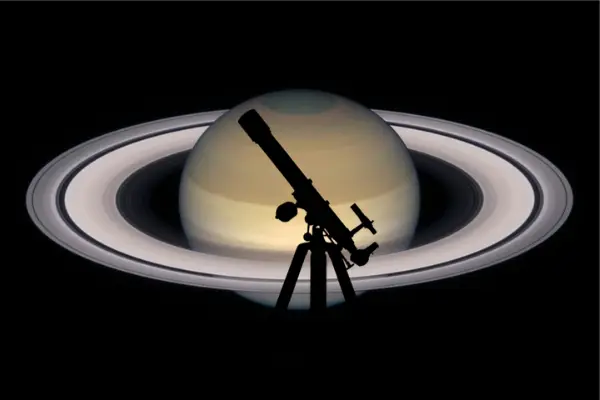
Best Beginner Telescope
Celestron – PowerSeeker 80EQ
- Aperture: 80 mm (3.15″)
- Focal length: 900mm
- Focal Ratio: f/11
- Mount: Equatorial
- Eyepiece: 20mm, 4mm
- Magnification: 45x, 225x
- Weight: 16.38 lbs (7.4 kg)
- Our Rating: 9/10
Prices pulled from the Amazon Product Advertising API on:
Product prices and availability are accurate as of the date/time indicated and are subject to change. Any price and availability information displayed on [relevant Amazon Site(s), as applicable] at the time of purchase will apply to the purchase of this product.
The 80EQ Power Seeker is a refractor telescope with a 80mm aperture and a focal length of 900mm. Its low price combined with excellent optics, easy assembly, clear instructions, included eyepieces and other features that make it easy to use even for beginners, make it an excellent choice for anyone wanting to learn more about the nighttime sky.
At f/11, there is some chromatic aberration but nothing significant enough to ruin high-power views with this telescope. The optical quality of the Powerseeker 70 is quite good.
The scope’s focuser is a 1.25” rack-and-pinion made mostly of plastic. The focuser even includes a tension adjustment knob, should you find the focuser to be too loose or too tight.
Since Celestron PowerSeeker 80EQ telescope is a family-friendly scope, it is very easy to set up and use as it needs no extra tools. The instructions manual clearly describes every setup step, giving clear information on each of the telescope’s parts and uses.
With an aperture of 80 mm (3.15″) and a focal length of 900 mm (35″), the Celestron Power Seeker telescope allows stargazers to see the Moon, Jupiter, Saturn and other celestial wonders with ease.
The 3x Barlow lens manages to triple the magnifying power of all eyepieces, while the 1.25″ Erect Image Diagonal makes the telescope ideal for both astronomical and terrestrial use.
The telescope includes fully coated optics, meaning that at least one lens in the telescope has been coated with multiple layers of substances designed to capture and focus the light that goes through the lens.
The equatorial mount supplied with the 80EQ is actually a good match for it. The motions are reasonably smooth, the mount’s extruded aluminum legs are quite steady with such a lightweight tube. Furthermore, the whole setup is pretty light at about 16 pounds.
The 80EQ PowerSeeker is the best telescope to see and photograph Saturn as it comes with a camera attachment that allows the user to take photographs of the objects being viewed.
Pros:
- Family-friendly, easy to setup and use
- Coated glass, decent optical components
- EQ mount with slow motion controls
- Budget option refractor telescope for astrophotography
- High and low power eyepieces
- Ideal for both terrestrial and celestial viewing
Cons:
- Not suitable for professional use
- Most components are built with plastic
Best Reflector Telescope
Orion 09007 SpaceProbe
- Type: Reflector
- Aperture: 130 mm(5.1″)
- Focal length: 650mm
- Focal Ratio: f/5
- Mount: Equatorial
- Eyepiece: 25mm, 10mm
- Magnification: 26x, 65x
- Weight: 24.2 lbs.(11 kg)
- Our Rating: 9/10
Prices pulled from the Amazon Product Advertising API on:
Product prices and availability are accurate as of the date/time indicated and are subject to change. Any price and availability information displayed on [relevant Amazon Site(s), as applicable] at the time of purchase will apply to the purchase of this product.
The Orion SpaceProbe 130ST Newtonian Reflector is an excellent and one of the best telescopes to see Saturn. It is well-suited for both beginners as well as intermediate stargazers.
The SpaceProbe 130ST is a 130mm f/5 Newtonian reflector telescope.
This 5.1″ aperture reflector telescope gathers an ample amount of light for great views of the planets and Moon, as well as brighter galaxies, nebulas, and star clusters
The telescope also comes with tools to help you assemble the product, and two eyepieces: 10mm for 65x, and a 25mm for 26x magnification, respectively.
The quick set-up and ease of use makes the SpaceProbe 130ST EQ a very versatile telescope which the whole family can enjoy.
This Orion space probe telescope also boasts a short 24″ long optical tube design which enhances its portability, while the 130mm optical diameter, and the 650mm focal length are in perfect balance with the f/5.0 focal ratio.
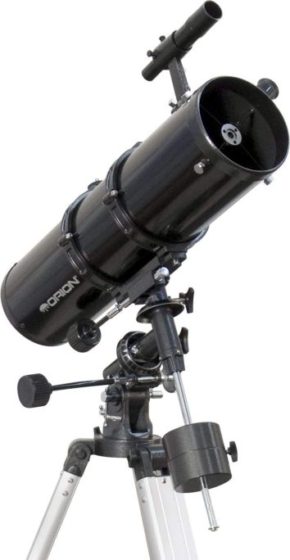
In addition, it possesses design features, such as a parabolic mirror and a specially designed holder for the secondary mirror, that focus the light captured by the aperture and use it to sharpen the images produced by the scope, even with its shorter tube.
The included aluminium tripod is very sturdy, and also includes an accessory tray that can be very useful when you are outdoors in the dark and need a place to organize your accessories neatly.
The equatorial mount is perfectly built and allows manual slow-motion tracking of celestial objects as they move across the sky.
The mount can also be upgraded at a later time to a motorized option that tracks objects automatically, so that’s a nice option to have and definitely a plus if you are using the Orion SpaceProbe 130ST for astrophotography.
Just like many other similar products, the Orion 09007 also comes with Orion’s Starry Night software, which is very useful for beginners, and has the added benefit of alerting the user of upcoming celestial events.
Short 24″ long optical tube design for easy portability and fast f/5 focal ratio for pleasing wide-field performance makes the SpaceProbe 130ST EQ a very versatile telescope the whole family can enjoy
Pros:
- Nice set of accessories
- Can be upgraded to have motorized tracking
- Comes with an Equatorial mount and a versatile tripod
- Easy to assemble and transport
Cons:
- Plastic focuser and mount parts
- Somewhat confusing instructions
Related
Best Compact Telescope
Celestron – PowerSeeker 127EQ
- Type: Reflector
- Aperture: 127 mm(5″)
- Focal length: 1000mm
- Focal Ratio: f/8
- Mount: German Equatorial
- Eyepiece: 20mm, 4mm
- Magnification: 50x, 250x
- Weight: 22.0 lbs.(10.0 kg)
- Our Rating: 9/10
Prices pulled from the Amazon Product Advertising API on:
Product prices and availability are accurate as of the date/time indicated and are subject to change. Any price and availability information displayed on [relevant Amazon Site(s), as applicable] at the time of purchase will apply to the purchase of this product.
The Celestron PowerSeeker 127EQ telescope is a Newtonian reflector, which means it uses mirrors to gather the light of the skies, and reflects it for viewing. With mirrors being much less expensive to produce than glass lenses, reflector telescopes offer more value in terms of inches of aperture.
The PowerSeeker 127EQ comes with two eyepieces (4mm and 20mm) and a 3x Barlow lens.
The 5-inch mirror on the 127mm PowerSeeker model limits useful magnification to about 250x, which is achieved using the 4mm eyepiece.
The larger 20mm eyepiece provides a more useful 50x magnification. This grows to 150x when coupled with the 3x Barlow.
If you’re considering an additional eyepiece, something like a 15mm Plossi would be a good option. This provides you with 66x magnification, or 198 when coupled with the Barlow.
The telescope is ideal for near and deep-sky observation, Celestron’s PowerSeeker 127EQ 127mm f/8 Reflector Telescope features a respectable focal length and a large, parabolic mirror that produce detailed images of the Moon, clear views of the planets, and the ability to resolve bright distant objects such as nebulae and galaxies.
The beauty of a Newtonian telescope is the longer focal lengths which can be offered in much shorter tube sizes—1000mm focal length in a tube which is only 20 inches (508mm) long .
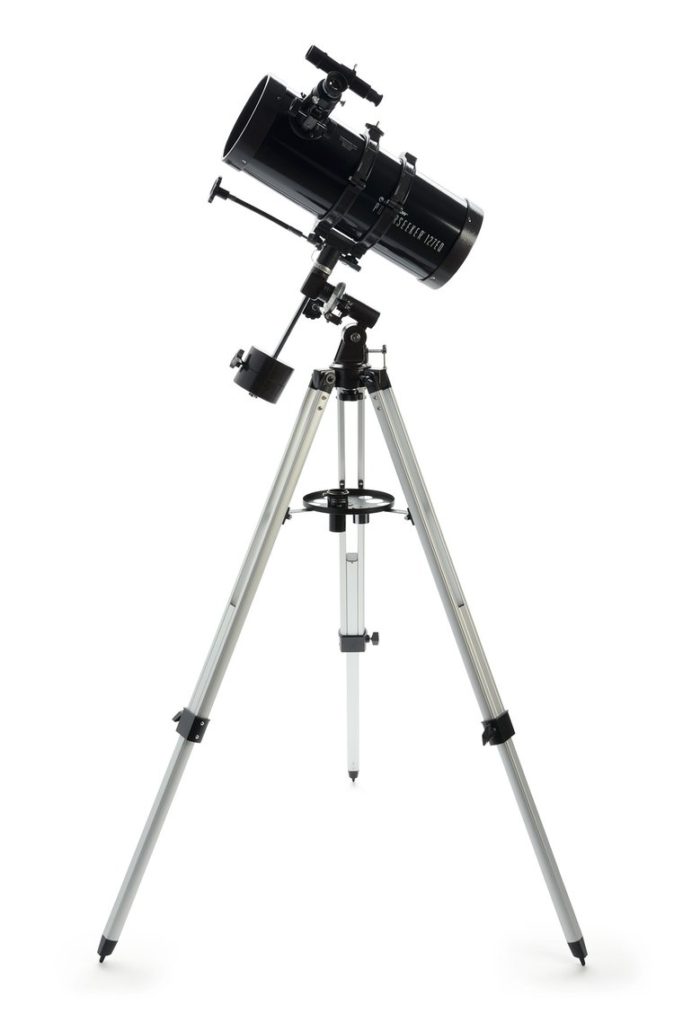
The PowerSeeker 127EQ is highly portable and one of the best telescope to see Saturn. You could easily fit this telescope and tripod in the trunk of a car and still have room for your other equipment, or maybe a late night picnic.
Additionally, you receive a copy of Starry Night astronomy software with a database of over 10,000 celestial objects.
Considering the telescope’s low price, compromises had to be made, and one such compromise is the use of a spherical mirror rather than a parabolic mirror.
Optical aberrations tend to be more common with spherical mirrors. This telescope does, however, feature an erect image diagonal for the right way up images, which prevents some aberration.
This telescope comes with an Equatorial mount, designed for astronomy telescopes. Included are two manual slow-motion controls, these allow for smoother tracking of objects as they pass across the night sky.
The tripod is made of aluminum, although lightweight, it is robust, solid and also comes with a very handy accessory tray which lets you keep extra eyepieces and T-rings for a camera, close to hand.
Pros:
- Solid build quality
- Stable mount
- Comes with a 3x Barlow lens
Cons:
- Spherical mirror leads to some amount of aberrations
- Occasional collimation of the mirrors required
Best Computerized Telescope
Celestron – NexStar 6SE
- Type: Schmidt-Cassegrain
- Aperture: 150mm (5.9″)
- Focal length: 1500mm
- Focal Ratio: f/10
- Mount: Computerized – Alt-Azimuth
- Eyepiece: 25mm
- Magnification: 60x
- Weight: 30 lbs. (13.6 kg)
- Our Rating: 9.6/10
Prices pulled from the Amazon Product Advertising API on:
Product prices and availability are accurate as of the date/time indicated and are subject to change. Any price and availability information displayed on [relevant Amazon Site(s), as applicable] at the time of purchase will apply to the purchase of this product.
The NexStar 6SE offers consumers the proven quality of the Celestron brand in a compact, portable, and technologically advanced telescope.
The scope’s 6-inch aperture, portable design, fully functional computer, and extensive database, among other features, make it easy to use, easy to transport, and easy to enjoy regardless of experience level. The NexStar 6SE is quite evidently the best computerized telescope to see Saturn.
The NexStar 6SE is a 6-inch Schmidt Cassegrain Telescope, which has an actual aperture of 150 mm and focal length of 1,500 mm, giving it a focal ratio of f/10. The OTA comes on a Vixen-style dovetail bar, which fits into the dovetail saddle on the mount.
The telescope also comes with a 1.25” prism diagonal, 25 mm Plossl eyepiece (providing 60x when used with the 6SE) and Celestron’s StarPointer, which is a zero-power red-dot-style finder.
The Celestron NexStar 6 SE is a solid and sturdy telescope, perfect for home use and astrophotogaphy.
The Celestron NexStar 6 SE is easy to align with Celestron’s SkyAlign Go-To Alignment system.
On average it takes a new telescope user approximately 5 minutes to do a full sky alignment with the NexStar 6 SE.
Once aligned, the telescope is incredibly easy to operate. The hand controller on the NexStar 6SE allows you to move the telescope at your discretion. If you are looking for a telescope that can help you transition from beginner to a bit advanced astronomer without much guidance then look no further than the NexStar 6SE as it one of the best rated computerized telescope that money can buy.
The NexStar 6SE’s hand controller offers a tour of the night sky and easily allows you to locate planets, galaxies or any of the 40,000 celestial objects in its database.
To power the 6SE you have two options, 8x AA batteries or 12v DC power supply. The 8x AA batteries would last you about 3 hours (included alignment of finderscope and general terrestrial viewing and the 40 minute observation session).
You can download all the available upgrades from Celestron’s website. In this way, you can keep your telescope up to date, and you can even control your telescope via computer.
The 6SE makes a good choice for consumers living in areas with light-pollution who are looking for clarity and accuracy in their viewing experience.
It is also one of the best telescope to see Saturn under $1000 those who are willing to invest a fair sum of money into the hobby in order to learn more about the star gazing experience. Also, the 6SE is a good choice even for more experienced star gazers who wish to have a more portable scope for easier transport and for viewing deep space objects.
Pros:
- Easy to mount and to use
- Good optics
- It’s very sturdy and low maintenance
- Motorised and automated GoTo mount
- Portable, fits perfectly in the back of any normal car
Cons:
- 8 AA batteries tend to drain out fairly quickly
- User manual and instructions are not very clear
Best Budget Telescope To See Saturn
Celestron – PowerSeeker 70EQ
- Aperture: 70mm (2.8″)
- Focal length: 700mm
- Focal Ratio: f/10
- Mount: Equatorial
- Eyepiece: 20mm, 4mm
- Magnification: 35x, 175x
- Weight: 13.9 lbs.(6.3 kg)
- Our Rating: 9/10
Prices pulled from the Amazon Product Advertising API on:
Product prices and availability are accurate as of the date/time indicated and are subject to change. Any price and availability information displayed on [relevant Amazon Site(s), as applicable] at the time of purchase will apply to the purchase of this product.
The 70EQ Power Seeker is a perfect refractor telescope to see Saturn with a 70mm aperture and a focal length of 700mm. Its low price combined with excellent optics, easy assembly, clear instructions, included eyepieces and other features that make it easy to use even for beginners, make it an excellent choice for anyone wanting to learn more about the nighttime sky.
At f/10, there is some chromatic aberration but nothing significant enough to ruin high-power views with this telescope. The optical quality of the Powerseeker 70 is quite good.
The scope’s focuser is a 1.25” rack-and-pinion made mostly of plastic. The focuser even includes a tension adjustment knob, should you find the focuser to be too loose or too tight.
Since Celestron 21037 PowerSeeker 70EQ telescope is a family-friendly scope, it is very easy to set up and use as it needs no extra tools. The instructions manual clearly describes every setup step, giving clear information on each of the telescope’s parts and uses.
With an aperture of 70 mm (2.76“) and a focal length of 700 mm (28”), the Celestron Power Seeker telescope allows stargazers to see the Moon, Jupiter, Saturn and other celestial wonders with ease.
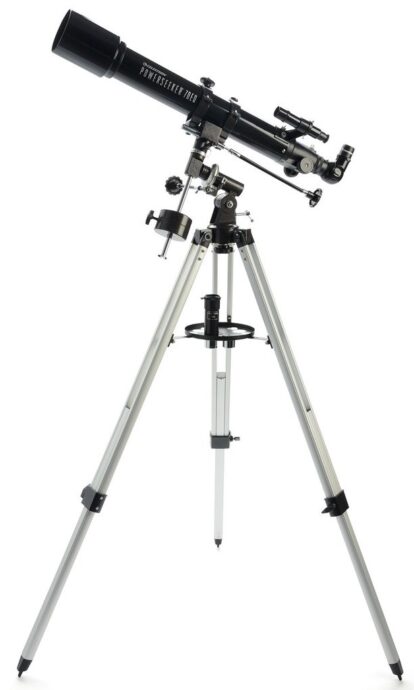
The 3x Barlow lens manages to triple the magnifying power of all eyepieces, while the 1.25″ Erect Image Diagonal makes the telescope ideal for both astronomical and terrestrial use.
The telescope includes fully coated optics, meaning that at least one lens in the telescope has been coated with multiple layers of substances designed to capture and focus the light that goes through the lens.
The equatorial mount supplied with the 70EQ is actually a good match for it. The motions are reasonably smooth, the mount’s extruded aluminum legs are quite steady with such a lightweight tube. Furthermore, the whole setup is pretty light at about 14 pounds.
The 70EQ PowerSeeker is also the best budget telescope for smartphone astrophotography as it comes with a camera attachment that allows the user to take photographs of the objects being viewed.
Pros:
- Family-friendly, easy to setup and use
- Coated glass, decent optical components
- EQ mount with slow motion controls
- Budget option refractor telescope for astrophotography
- High and low power eyepieces
- Ideal for both terrestrial and celestial viewing
Cons:
- Not suitable for professional use
- Most components are built with plastic
Best Telescope To Photograph Saturn
Sky-Watcher ProED Doublet APO
- Type: Apochromatic Refractor
- Aperture: 80 mm(3.2″)
- Focal length: 600mm
- Focal Ratio: f/7.5
- Eyepiece: 20mm, 5mm
- Weight: 6.6 lbs.(3 kg)
- Our Rating: 9.2/10
Prices pulled from the Amazon Product Advertising API on:
Product prices and availability are accurate as of the date/time indicated and are subject to change. Any price and availability information displayed on [relevant Amazon Site(s), as applicable] at the time of purchase will apply to the purchase of this product.
Sky-Watcher’s ProED series provides fantastic value for the price. The ProED 80, in particular, is an excellent scope for the beginning astrophotographer, or as a grab n’ go visual instrument.
The ProED scopes all use a standard achromatic doublet design with FPL-53 and Schott glass in the lens elements.
The scope’s slow focal ratio of f/7.5 additionally helps with controlling chromatic aberration, and makes it easy to achieve high magnification without ultra-short focal length eyepieces.
Its two-speed Crayford-style focuser helps make fine-focusing fast and precise without backlash. The EvoStar comes with several accessories to help you get observing faster and easier.
First, are two long eye relief eyepieces that produce 30x and 120x magnification, a 90° star diagonal for more comfortable viewing, and a large 8×50 erect-image finderscope to make finding your celestial objects faster and easier.
This Doublet APO Refractor Telescope comes with a 2” Crayford-style focuser which is one of the best focusers in telescopes as it is a Dual-speed one. A 1.25-inch adapter is also included along with it.
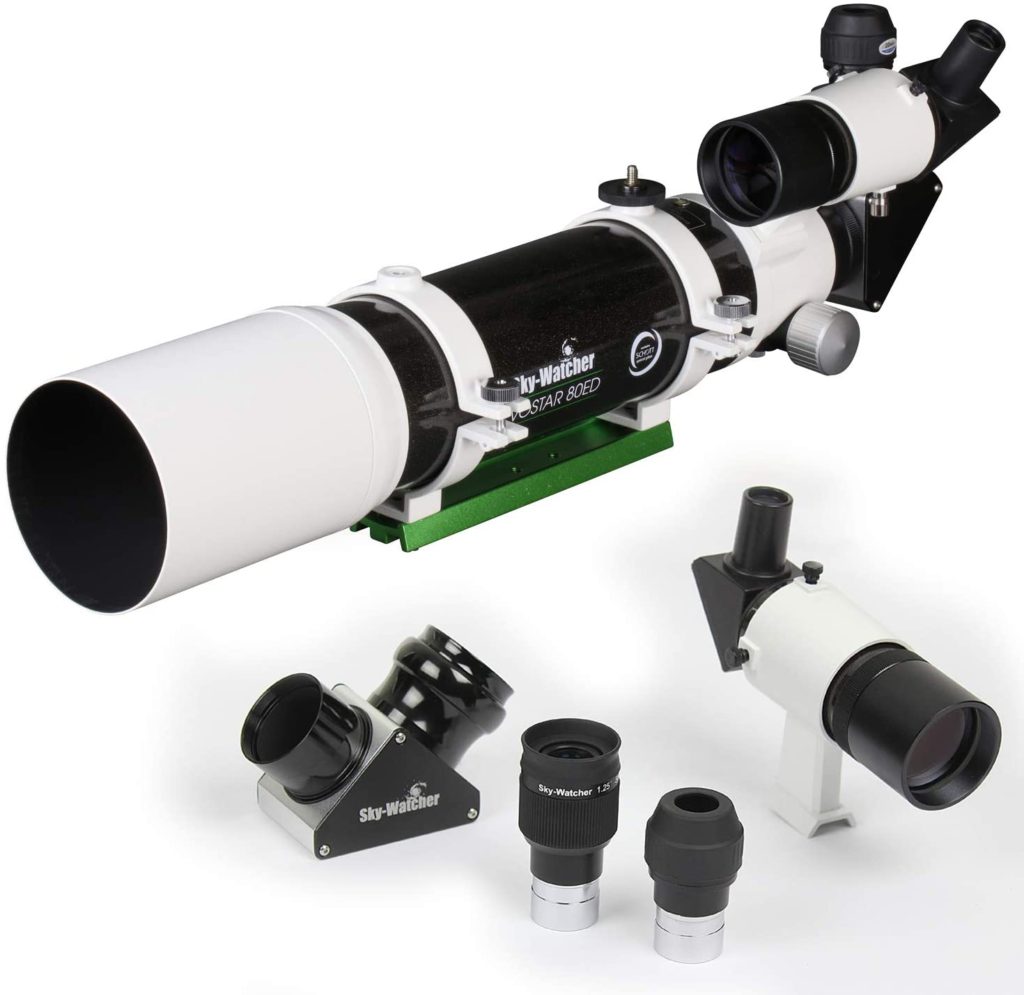
With a petite footprint, the Sky-Watcher Evostar 80ED Pro is a light, compact instrument that fits into a small space while providing easy portability.
If you want to try your hand at astrophotography, then the Sky-Watcher ProED 80mm Doublet APO Refractor Telescope is the ideal optical tool for it.
This powerful, yet affordable telescope delivers the kind of quality we would expect from a far more expensive telescope, for only a fraction of the price.
Due to the extra-low dispersion (ED) grade-A glass doublet, you will have an amazing color correction that will make your photos more reliable, taking them closer and closer to the reality.
The Sky-Watcher Pro Apochromatic Telescope has enough high contrast/high resolution optical performance to let you use it on an alt-azimuth or equatorial mount.
It’s only 6.6 lbs., lightweight and doesn’t require a big and expensive mount, so it’s easy to afford and easy to take out and set up for observing on a moment’s notice.
The Sky-Watcher ED-APO features a contrast-enhancing internal light baffles in the tube and focuser drawtube and a specially darkened tube interior providing dark sky backgrounds and high terrestrial contrast.
This apochromatic telescope comes with a dew shield which slows the formation of dew on the lens in cold weather to extend your undisturbed observing time.
Pros:
- Best for professionals
- Maximum magnification
- Accurate in focus
- 8×50 RA viewfinder
- Two-inch dielectric diagonal
Cons:
- Focuser slips with heavy eyepieces
- Flimsy case
Best Dobsonian
Orion 10014 SkyQuest XT4.5
- Type: Newtonian Reflector
- Aperture: 114mm (4.5”)
- Focal length: 900mm
- Focal Ratio: f/7.9
- Mount: Dobsonian
- Eyepiece: 25mm, 10mm
- Magnification: 36x, 91x
- Weight: 22 lbs. (10kg)
- Our Rating: 9.2/10
Prices pulled from the Amazon Product Advertising API on:
Product prices and availability are accurate as of the date/time indicated and are subject to change. Any price and availability information displayed on [relevant Amazon Site(s), as applicable] at the time of purchase will apply to the purchase of this product.
The Orion SkyQuest XT4.5 Classic Dobsonian telescope has been designed with ease-of-use in mind. It’s a true “Dobsonian” telescope, having all the great features and value that make the Dobsonian reflector design so popular.
The SkyQuest XT4.5 collects a whopping 260% more light than a typical 60mm-aperture beginner telescope – which simply means hundreds more objects will be visible through this classic dobsonian.
With it’s 4.5″ aperture and 900mm focal length you can have the clear views of lunar craters and plains on the Moon, planets, bright nebulas and galaxies.
You can even see Jupiter’s cloud band, Saturn’s rings.
The XT4.5 is easily the best dobsonian telescope as it is compact and lightweight compared to its competitors.
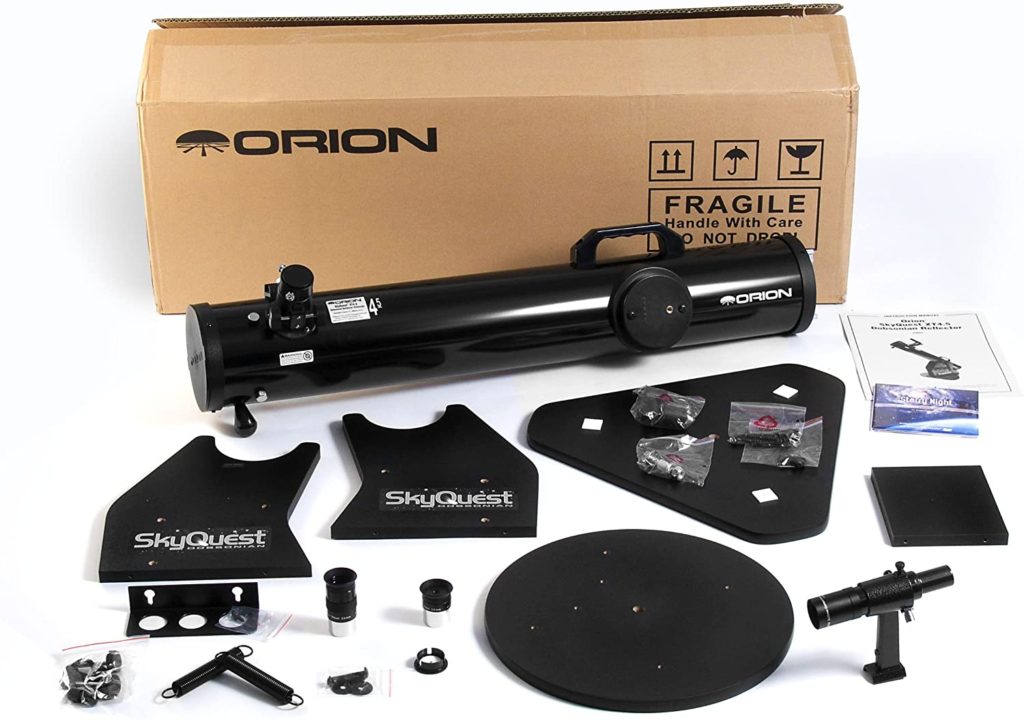
The Orion SkyQuest XT4.5 comes with some amazing accessories. You get a 6×26 Orion achromatic correct-image finder scope and a “navigation knob” for easy slewing of the telescope.
You also get two fully coated Orion 1.25″ Sirius Plossl eyepieces: a 25mm for low-power views at 36x, and a 10mm for getting in close at 91x.
The Orion SkyQuest XT4.5 is one of the best dobsonian telescope for beginners, it’s not a toy. It’s a quality astronomical instrument capable of delivering high-resolution images of astronomical objects.
The SkyQuest XT4.5 comes with a wooden Dobsonian base. The base also has some Nylon bearing pads, which prevent the scope from moving from position, allowing you to have a vibrations free viewing.
Pros:
- Affordable telescope with a great quality-price ratio
- Very good optical and mechanical performance
- Fully accessorized
- Perfect for amateurs with its simple and stable configuration
Cons:
- Short eyepiece height
- Plastic focuser
Best GoTo Telescope
Celestron – NexStar 127SLT
- Type: Schmidt-Cassegrain
- Aperture: 127mm (5″)
- Focal length: 1500mm
- Focal Ratio: f/12
- Mount: Computerized Alt-az
- Eyepiece: 25mm, 9mm
- Magnification: 60x, 167x
- Weight: 18.0 lbs.(8.2 kg)
- Our Rating: 9.6/10
Prices pulled from the Amazon Product Advertising API on:
Product prices and availability are accurate as of the date/time indicated and are subject to change. Any price and availability information displayed on [relevant Amazon Site(s), as applicable] at the time of purchase will apply to the purchase of this product.
The Celestron NexStar 127SLT is an entry-level GoTo telescope designed for anyone looking for a reliable telescope with which to enjoy the nighttime sky.
The telescope features a 127mm aperture and Celestron’s SkyAlign technology, this telescope offers consumers good views. In addition, the telescope’s single fork arm and simple design make it easy to set up and use.
The scope’s focal length is 1500mm, and it has a focal ratio of f/12. As far as eyepieces are concerned, each Celestron NexStar 127 SLT telescope comes with a 25mm eyepiece and a 9mm eyepiece, having a maximum magnification of 167x with the default 9 mm eyepiece.
The Celestron NexStar 127 SLT telescope stands on top of a motorized Altazimuth mount, which can be controlled via the provided digital hand controller.
Alternatively, the mount can be hooked to a computer for increased precision.
With preassembled, adjustable stainless steel tripods, and quick release fork arms and tubes, the NexStar 127 SLT telescope can be set up in a matter of minutes with no tools required.
The 127 SLT with its large aperture is great for viewing the surface of the moon, phases of Venus, rings of Saturn or Jupiter and its four largest moons, and other deep-space objects.
The Celestron NexStar 127SLT is also the best goto telescope to see Saturn.
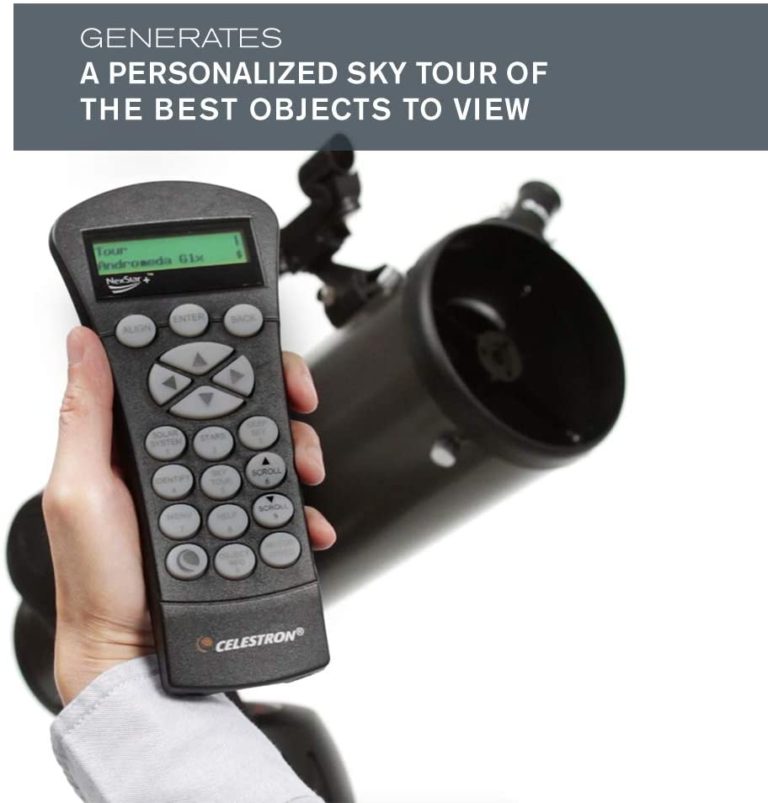
The Celestron NexStar GoTo mounts are powered by eight AA user-supplied batteries, or an optional AC adapter, making them perfect as a travel telescope.
With Celestron’s SkyAlign Technology, aligning your telescope is fast and easy. Simply input the date, time and location (the CPC models have built-in GPS that does this for you) and then align the telescope to three bright stars of your choosing.
You do not need to know the names of the stars, you can even pick the moon or bright planets. The NexStar computer system will automatically figure out which stars were chosen and then align the telescope.
The 127SLT’s diagonal is a prism, and a nice one at that – unlike the cheap diagonals supplied with many entry-level scopes which are cheap mirrors that aren’t very flat, which tend to offer dim and fuzzier images.
Pros:
- Super optical construction
- Very easy to operate with
- Compact and portable design
- Included needed additional accessories
- Suitable for lunar/planetary astrophotography
Cons:
- 8 AA batteries required but not included
- Tripod can be more stable
Best Portable Telescope
Celestron – NexStar 130SLT
- Type: Newtonian Reflector
- Aperture: 130mm (5.12″)
- Focal length: 650mm
- Focal Ratio: f/5
- Mount: Computerized Alt-az
- Eyepiece: 25mm, 9mm
- Magnification: 26x, 72x
- Weight: 18.0 lbs.(8.2 kg)
- Our Rating: 9.4/10
Prices pulled from the Amazon Product Advertising API on:
Product prices and availability are accurate as of the date/time indicated and are subject to change. Any price and availability information displayed on [relevant Amazon Site(s), as applicable] at the time of purchase will apply to the purchase of this product.
The NexStar 130SLT is a unique reflector telescope from Celestron. The reflector technology uses mirrors to obtain the maximum amount of light possible and therefore to produce images of remarkable clarity, even when located deep in space.
It’s a 130mm f/5 Reflector Telescope which is a complete platform for making observations of the Moon, planets, and bright deep-space objects such as binary stars, star clusters, galaxies and nebulae.
With a focal length of 650mm, this model is an f/5 scope. F/5 scopes are fairly fast, meaning that you have a wide field of view, which is useful for short exposure astrophotography of big portions of the sky.
The Celestron NexStar 130 SLT Computerized Telescope removes the issue of struggling to find a planet or star using a paper star map.
It is no doubt one of the best computerized telescope to see Saturn. With the Celestron NexStar 130 SLT Computerized Telescope comes a handheld computer that features SkyAlign technology incorporated right into the telescope, automatically finding and pointing the telescope to the planet or star that you would like to see by way of a few button presses.
This is an ideal telescope if you plan to travel or do stargazing from home or your backyard along with your family
This telescope comes with a pre-assembled, adjustable stainless-steel tripod, quick release fork arm, NexStar+ computerized hand control, 130mm Newtonian Reflector optical tube, and lots of amazing accessories.
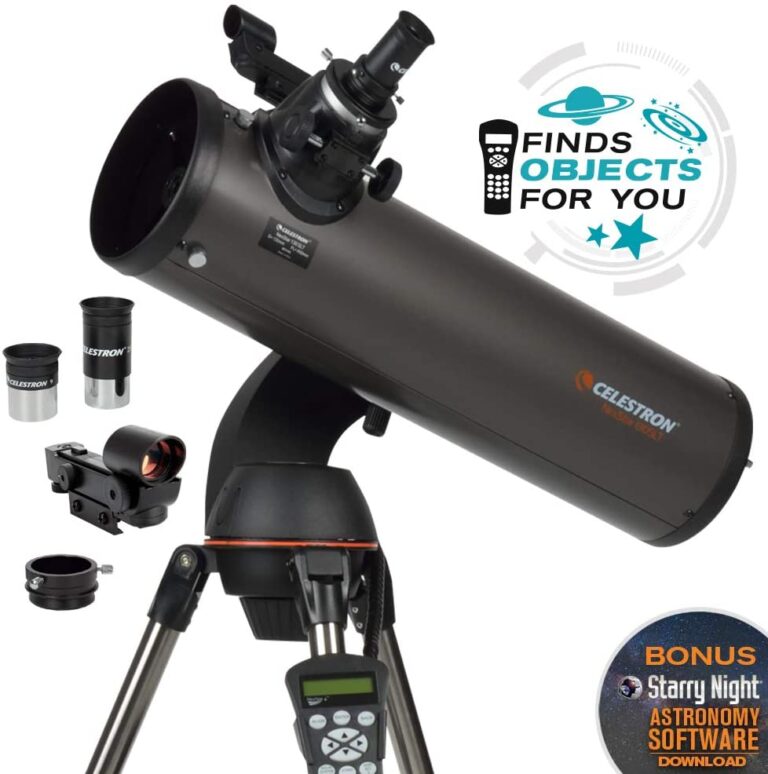
The Celestron NexStar 130SLT is designed to maximize celestial views. The scope does so by using its reflector method to bring about clear views of details such as the Hercules globular cluster, stars, or the Great Orion Nebula. These views are made possible by the telescope’s ability to use mirrors to collect and distribute the light that creates the detailed views of far away objects.
The computerized hand control of this SLT telescope gives you the ability to automatically slew to any of its 40,000+ objects, including over 600 galaxies, 300 clusters, stars and planets.
For astrophotography since The NexStar SLT telescopes use Alt-Az mounts, you will be limited to short exposure photographs.
With the high aperture of the NexStar 130 SLT, Deep Sky Observation with medium-length exposure times are certainly possible.
For example, you will be able to get some great shots of the Moon (closeups and wide shots), while also being able to photograph some nebulae and other deep sky formations and objects. The reason for this is that Newtonians like NexStar 130 SLT have a fairly wide field of view.
Pros:
- Wide field of view
- Handheld computer makes it easy to find celestial bodies
- Weighs only 18 pounds for simple transport
- Deep views of the sky
Cons:
- Wide field of view
- Handheld computer makes it easy to find celestial bodies
- Weighs only 18 pounds for simple transport
- Deep views of the sky
Best For Amateurs
Celestron – AstroMaster 130EQ
- Type: Reflector
- Aperture: 130 mm(5.1″)
- Focal length: 650mm
- Focal Ratio: f/5
- Mount: Equatorial
- Eyepiece: 20mm, 10mm
- Magnification: 32.5x, 65x
- Weight: 28.0 lbs.(12.7 kg)
- Our Rating: 9.2/10
Prices pulled from the Amazon Product Advertising API on:
Product prices and availability are accurate as of the date/time indicated and are subject to change. Any price and availability information displayed on [relevant Amazon Site(s), as applicable] at the time of purchase will apply to the purchase of this product.
The Celestron PowerSeeker 127EQ telescope is a Newtonian reflector, which means it uses mirrors to gather the light of the skies, and reflects it for viewing. With mirrors being much less expensive to produce than glass lenses, reflector telescopes offer more value in terms of inches of aperture.
The PowerSeeker 127EQ comes with two eyepieces (4mm and 20mm) and a 3x Barlow lens.
The 5-inch mirror on the 127mm PowerSeeker model limits useful magnification to about 250x, which is achieved using the 4mm eyepiece.
The larger 20mm eyepiece provides a more useful 50x magnification. This grows to 150x when coupled with the 3x Barlow.
If you’re considering an additional eyepiece, something like a 15mm Plossi would be a good option. This provides you with 66x magnification, or 198 when coupled with the Barlow.
The telescope is ideal for near and deep-sky observation, Celestron’s PowerSeeker 127EQ 127mm f/8 Reflector Telescope features a respectable focal length and a large, parabolic mirror that produce detailed images of the Moon, clear views of the planets, and the ability to resolve bright distant objects such as nebulae and galaxies.
The beauty of a Newtonian telescope is the longer focal lengths which can be offered in much shorter tube sizes—1000mm focal length in a tube which is only 20 inches (508mm) long .
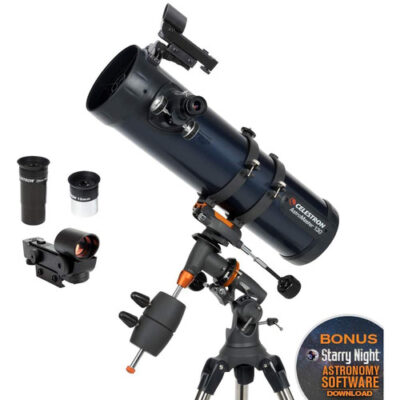
The PowerSeeker 127EQ is highly portable and one of the best telescope to see planets for adults & teenagers alike. You could easily fit this telescope and tripod in the trunk of a car and still have room for your other equipment, or maybe a late night picnic.
Additionally, you receive a copy of Starry Night astronomy software with a database of over 10,000 celestial objects.
Considering the telescope’s low price, compromises had to be made, and one such compromise is the use of a spherical mirror rather than a parabolic mirror.
Optical aberrations tend to be more common with spherical mirrors. This telescope does, however, feature an erect image diagonal for the right way up images, which prevents some aberration.
This telescope comes with an Equatorial mount, designed for astronomy telescopes. Included are two manual slow-motion controls, these allow for smoother tracking of objects as they pass across the night sky.
The tripod is made of aluminum, although lightweight, it is robust, solid and also comes with a very handy accessory tray which lets you keep extra eyepieces and T-rings for a camera, close to hand.
Pros:
- Solid build quality
- Stable mount
- Comes with a 3x Barlow lens
Cons:
- Spherical mirror leads to some amount of aberrations
- Occasional collimation of the mirrors required
Best Tabletop Pick
Orion 10015 StarBlast 4.5
- Type: Newtonian Reflector
- Aperture: 115mm (4.53″)
- Focal length: 450mm
- Focal Ratio: f/4
- Mount: Altazimuth
- Eyepiece: 17mm, 6mm
- Magnification: 26x, 75x
- Weight: 13 lbs(5.9 kg)
- Our Rating: 9/10
Prices pulled from the Amazon Product Advertising API on:
Product prices and availability are accurate as of the date/time indicated and are subject to change. Any price and availability information displayed on [relevant Amazon Site(s), as applicable] at the time of purchase will apply to the purchase of this product.
The Orion StarBlast 4.5 (10015) is an excellent choice of telescope for beginners who are eager to begin their astronomical careers, as well as for intermediate astronomers looking for a budget travel telescope, who can utilize its features for the best extraterrestrial viewing.
You don’t have to spend time assembling the Orion 10015 StarBlast 4.5 Astro Reflector, as the telescope arrives pre-built so that anyone can take it out of the box and begin using it right away. It’s a great compact and highly portable budget telescope for beginners and families.
The scope features a substantial 4.5″ aperture and f/4 focal ratio that provides bright, detailed views of solar system targets like the Moon and planets, as well as wide-field celestial objects like nebulas and star clusters.
The telescope’s lens is made of a low thermal expansion borosilicate glass. This means that it is capable of focusing light with increased precision.
The StarBlast’s included red-dot finder is more than adequate, thanks to its extremely wide field of view.
The model only comes with a tabletop mount, so it really can only be used indoors or outdoors on a picnic table or similar piece of patio furniture.
Its table top design makes it one of the best portable telescopes for the money. It has a wider footprint than some competing models, which makes it more steady and less prone to being knocked over.
On clear nights, you will be able to view not only the Moon and its craters, but also Jupiter, Saturn, and its beautiful rings.
The scope’s Dobsonian mount means that beginners and new users can point easily. All in all, the Orion Starblast 4.5 will enchant even advanced users with its bright images of the galaxies, nebulas, and star clusters.
Pros:
- Simple to use
- Equipped with EZ Finder for easy aiming
- Includes Starry Night astronomy software
- Features a fast-focal ratio
- Comes pre-assembled
- Two eyepieces along with a dust cover in this telescope
Cons:
- Cannot attach DSLRs
- Collimation process takes a lot of time
Best Telescope To See Saturn - Buying Guide
Buying a telescope for home use is an important step towards a new level of appreciation for the night sky, and the wonders found within it.

Buying a telescope to see Saturn and other celestial bodies is an important step towards a new level of appreciation for the night sky, and the wonders found within it.
The best telescope to see Saturn is one that guides you and your family through the process of learning the night sky in a straightforward and gratifying way. It’s easy to get swept away with an optical instrument that is likely too complex for kids or other members of your family at home to learn early on.
Features To Consider When Choosing A Good Telescope To See Saturn
Aperture
Aperture is the diameter, usually measured in millimeters, of the objective (primary) lens or mirror of the telescope. Essentially, the larger the aperture, the brighter images will appear, and the deeper into space you will be able to see.
Focal Ratio
The focal ratio (f/5.9 for example) is the ratio between the aperture and the focal length. Multiply the aperture by the f ratio to find the focal length.
Focal Length
The focal ratio (f/5.9 for example) is the ratio between the aperture and the focal length. Multiply the aperture by the f ratio to find the focal length.
Magnification
To get an image suitable for observing with our eyes, a telescope uses a second lens, or collection of lenses, called an eyepiece at the focal plane. The eyepiece magnifies the image from the objective.
The eyepiece also has a focal length. The magnification of a telescope and eyepiece is very simple to calculate. If the focal length of the objective is “F” and the focal length of the eyepiece is “f”, then the magnification of the telescope/eyepiece combination is F/f. For example, if a telescope has an objective lens with focal length of 1200 mm (about 48”) and it has an eyepiece of focal length 25 mm (about 1”), then it will have a magnification of 1200/25=48x.
Eyepieces
Eyepieces determine the magnification and field of view of a telescope. Different eyepieces are used to view different objects.
Some objects, such as nebulae and star clusters, appear quite large and are best viewed at low magnifications (which give a wider field of view), whereas planets appear very small and are normally viewed with high-magnification eyepieces.
Most telescopes come supplied with one or two eyepieces. Ideally, you’d like to have a set that spans a range of magnifications.
You can expect to spend anywhere from $40 to $250 on a good eyepiece.
A Barlow lens is also worth considering: it multiplies each eyepiece’s power by two or three times, effectively doubling your eyepiece collection.
Finderscope
A good finderscope is essential for any telescope. It brightens and magnifies the view, allowing you to find things beyond the naked-eye limit.
When properly aligned, a finderscope also allows you to point a telescope more precisely than do peep sights or reflex finders. This is especially important whenever you’re aiming at a blank point in the sky where your charts tell you an interesting, faint object ought to be.
Types Of Telescopes
Refractor Telescope
When most people think of a telescope, the refractor type is what’s going to pop into their minds. This kind of telescope uses a lens to focus light on a single mirror, which is angled to direct the light through an eyepiece into your eye.
The simplicity and reliability of the design makes it easy to use and requires little maintenance. These are excellent for observing objects, planets, the Moon and the galaxies.
Since the optical system is basically a straight line, there are no obstructions from secondary mirrors as there are in Newtonians or catadioptrics.
Reflector Telescope
Reflector telescopes feature a clear piece of glass or plastic at the front of the tube. These don’t warp the light, so they aren’t lenses, but instead a protective shell to keep dust out.
A mirror sits at the back of the tube. It’s curved to focus light on a second mirror, which directs light through the eyepiece and to your eye.
Reflector telescopes are easily identified by the fact that the eyepiece is found near the telescope’s front. These tend to be the least expensive, and you can get larger apertures for a lower price than with other models. The one downside to reflector telescopes is that they must be calibrated regularly in a process called “collimation.”
Compound Telescope (Catadioptrics)
Compound telescopes use an initial lens to focus light onto a mirror at the back of the telescope. The mirror focuses light onto a smaller mirror mounted on the back of the lens, which directs light through a tube that runs through the center of the first mirror and out the back of the telescope.
Compound telescopes are very lightweight relative to other types, and they don’t require collimation like reflector telescopes do.
How to Find Saturn in the Night Sky Without A Telescope
The position of the planet Saturn in the night sky changes over time. It is orbiting the Sun just as Earth is, except that it takes Saturn 29-years (Earth years, of course), to complete its orbital period around the Sun.
The position of Saturn in your night sky will also depend on your location on Earth. Saturn is not always visible to everyone on Earth, because sometimes it lies too close to the Sun from our vantage point on Earth to view at night.
How To Find Saturn On Your Phone
To find the current location of Saturn, We suggest using an astronomy app such as Gas Giants or Star Walk 2 on your mobile phone with a Stellarium planetarium simulator. This will show you exactly where to look for Saturn from your location.
These apps can show you what’s in the sky and their exact position in real-time. Use the search function and enter the celestial object you wish to find, it will point you in the right direction. It’s easy and will save you some time. Once you know what you are looking out, point your telescope towards it and enjoy the view.
How To See Saturn’s Moons With A Telescope
Saturn has over 80 known moons, and 53 of them are officially named. Its biggest moon, Titan, is larger than the planet Mercury (but much lighter, due to its high ice content). Saturn also hosts six more good-size moons and dozens of house-size moonlets.
You can easily see Titan through a backyard telescope, plus three or four of the next largest, depending on the telescope’s aperture.
Even though Titan is far away, it’s large size means it’s a fairly bright and easy telescope target. A 6-inch or larger telescope may show the color of the dense yellow-orange clouds on this large 8th-magnitude moon,
This orange-brown target shines with a magnitude between 8.2 and 9.0 and orbits Saturn every 15 days.
To identify the moons using a sky-charting app like SkySafari 5, Star Walk or Stellarium Mobile, center Saturn and zoom in until you see the moons displayed. If the app time is set to Now, it will match what you see in your telescope, except for any image inverting or mirroring your telescope’s optics might introduce.
The Saturn Moons and Gas Giants apps for iOS are designed to provide realistic views of the planet and moons at any time you choose. They incorporate buttons to flip the view to match your telescope’s optics.
Saturn’s moons are worlds unto themselves — massive enough to have geologic activity, interesting terrain, subsurface liquid saltwater oceans and even atmospheres.
Conclusion
Our pick for the best beginner telescope to see Saturn is the Celestron – PowerSeeker 80EQ. You’ll be ready to observe in minutes thanks to the quick and easy no-tool setup. The 80EQ provides bright, clear images of the Moon, planets, star clusters, and more for great nighttime viewing.
Our next pick for the best reflector telescope to see Saturn is the Orion 09007 SpaceProbe. This 5.1 inch aperture reflector telescope gathers an ample amount of light for great views of the planets and Moon, as well as brighter galaxies, nebulas, and star clusters
Short 24 inch long optical tube design for easy portability and fast f/5 focal ratio for pleasing wide-field performance makes the SpaceProbe 130ST EQ a very versatile telescope the whole family can enjoy.
Our next pick is the Celestron – NexStar 6SE Telescope. The NexStar 6SE Computerized Telescope features Celestron’s iconic orange tube design with updated technology and the latest features for amazing stargazing for beginners and experienced observers.
The six-inch primary mirror in this Schmidt-Cassegrain telescope for adults and kids to be used together packs enough light-gathering ability to observe the best that our Solar System has to offer, while retaining a compact form factor.
Written by:
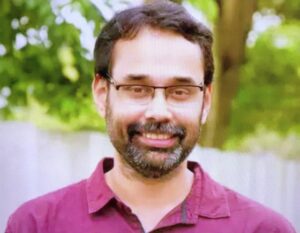
Chandrashekhara Rao
I grew up in a rural community with a dark sky, and that is where I learned to appreciate planets and stars at an early age. I have been fascinated with all things astronomical since I was a kid and started with a cheap-and-cheerful 60mm refractor on a wobbly tripod.
ABOUT US
We are a team of active amateur astronomers, here to help you with all your astronomy and science related needs – this is anything, from reviewing the latest telescopes to be released to talking about gravity and neurons. The Big Bang Optics was started because of our love for astronomy and to help others like us find the best telescope and accessories.
LEGAL DISCLAIMER
The Big Bang Optics is a participant in the Amazon Services LLC Associates Program, an affiliate advertising program designed to provide a means for sites to earn advertising fees by advertising and linking to Amazon.com. The Big Bang Optics also participates in affiliate programs with Clickbank and other sites. The Big Bang Optics is compensated for referring traffic and business to these companies.



